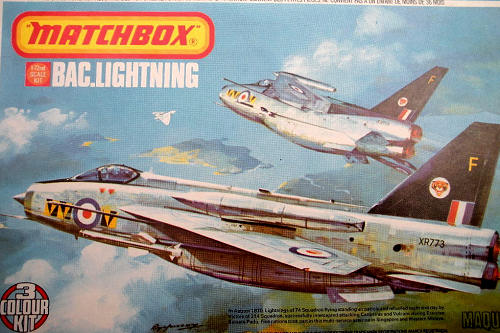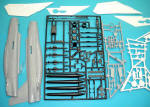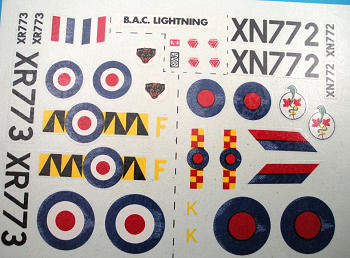
Matchbox 1/72 BAC Lightning F.2A/F.6
| KIT #: | PK-114 (1976) |
| PRICE: | Currently out of production |
| DECALS: | Twe options |
| REVIEWER: | Victor Scheuerman |
| NOTES: |

| HISTORY |
Resulting from an
experimental requirement for a supersonic research aircraft, the P1
prototype had obvious possibilities for full operational use. The P1A became
the basis for specification F23/49 issued in September 1949. Three aircraft
were ordered in April 1950 and the first flight was on August 4, 1954.
During November 1956 the P1B was ordered in quantity and in early 1957 flew
in this modified form with a redesigned fuselage and powered by two Avon 200
engines. The P1B was the first British aircraft to exceed Mach 2 in level
flight and had a phenomenal rate of climb. The name Lightning was announced
in October 1958 and the aircraft was developed
over many years resulting in the F.1, 1A, 2, 2A, 3 and the F.6. There were
also export versions that went to Saudi Arabia and Kuwait, the only foreign
customers. (Thanks mainly to the kit instruction sheet).
The F.2A and F.6 offered some similar external details that allow them to be covered in one boxing. BACs F.2As were modified F.2s that were upgraded with; enlarged belly fuel tank, extended and cambered wings, enlarged and squared-tipped fin that were all used on the F.6.
| THE KIT |
 Matchbox’s
single-seat Lightning has a total of 60 parts including a clear one-piece
canopy. The exterior is a combination of fine raised panel lines, well-done
engraved panel and speed brake panel lines and wildly overdone raised round
access locations and control hinges on the main wings. One of the details
that Matchbox captured quite well is the camber on the wings lower leading
edge.
Matchbox’s
single-seat Lightning has a total of 60 parts including a clear one-piece
canopy. The exterior is a combination of fine raised panel lines, well-done
engraved panel and speed brake panel lines and wildly overdone raised round
access locations and control hinges on the main wings. One of the details
that Matchbox captured quite well is the camber on the wings lower leading
edge.
The kit cockpit is
better then normal as it has a separate tub (with side consoles) that holds
the ejection seat, pilot and control column. An aft bulkhead is supplied and
a hint of the instrument panel is molded to the fuselage halves
Moving on to the
landing gear, this shows that the nose gear bay is framed in, though a
little shallow as is the norm for these kits. Unfortunately, the main gear
bays in the thin wing are not, and as these aircraft have a mid-fuselage
mounted wings, this may be noticeable on a built kit. Matchbox supplies a
well detailed nose leg that has the tire molded with the strut. Main gear
legs are a combination of a main strut that has separate retraction arms
added outboard and main tires with well detailed outer face wheels. The gear
doors are well done with the main outer ones having the iconic concave
surface to accommodate the main tires. However, all would look better sanded
thinner.
Other external
stores are the option of the Red Top or Firestreak missiles, large over-wing
fuel tanks, arrestor hook and air refueling probe and the two different
upper nose panel inserts. One being blank for the F.6 (cannons located in
the front of the belly tank), while the cannon outlets are for the F.2A that
still had the 30 MM cannons in the nose.
 Assembly
is clearly covered in ten well illustrated steps with detailed colour notes
offered at the end. There are two
decal options and both are RAF subjects. A partially camouflaged F.2A of 92
Squadron features dark green upper surfaces along with the main wing lower
leading edge. It also shows the missiles painted this green. However, the
Brits do love their unit insignia and colours and the yellow/red checkered
nose nicely compliments the green cobra entwining with a sprig of red maple
leafs unit insignia on the tail. This Germany based machine has low-viz
national insignia.
Assembly
is clearly covered in ten well illustrated steps with detailed colour notes
offered at the end. There are two
decal options and both are RAF subjects. A partially camouflaged F.2A of 92
Squadron features dark green upper surfaces along with the main wing lower
leading edge. It also shows the missiles painted this green. However, the
Brits do love their unit insignia and colours and the yellow/red checkered
nose nicely compliments the green cobra entwining with a sprig of red maple
leafs unit insignia on the tail. This Germany based machine has low-viz
national insignia.
A rather splendid
looking bare-metal F.6 of No 74 (Tiger) Squadron is the second option.
Thankfully it features the fin in full black with the tiger head in a disc
and this goes great with the yellow/black unit colours on the nose. This
aircraft features the large high-viz insignia In addition to the mentioned
decals, only some very basic stenciling is offered. Even though an older
mold, the kit decals still look useable.
| CONCLUSIONS |
While not a bad
kit, it has been superseded by a superior offering from Trumpeter and
Academy also promises a new molding in the near future.
November 2008
If you would like your product reviewed fairly and quickly, please contact me or see other details in the Note to Contributors.